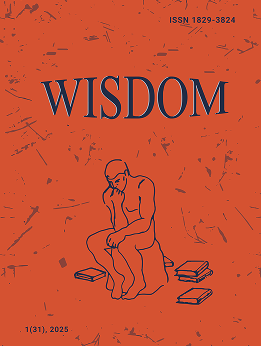Linguistic Structural Conceptual Framework of Literary Non-Fiction
DOI:
https://doi.org/10.24234/wisdom.v13i2.278Keywords:
literary non- fiction, author and reader, description, memoirs, linguistic study of genre, elicitation of data, therapeutic influence, speech and expressive movements, psycholiguisticsAbstract
This paper is an attempt to study the linguistic layer of the memoir-writing genre primarily as exploration of linguistic mentality of a person (linguistic person, character), through which both the human being and the social environment become recognizable.
This research describes the conceptual framework of the linguistic structure of the literary nonfiction by employing the following two principles: definition of the linguistic complexity of text-writing techniques and presentation of aesthetic value of these texts.
A number of descriptive, stylistic and structural methods employed in the study show that memoir writing undergoes significant changes and enriches itself through various linguistic forms and internal conceptual frameworks. The author’s presence in the text is often manifested through its original word structure essentially expressed in the common stylistic system of the work. References to time and places in texts present non-fiction character in a new light. The writer’s primary goal is not enriching the literary language, but ensuring the composition’s linguistic authenticity and individuality. Flexibility of the genre is enhanced by intertextual manifestations. Lastly, memoir-writing may have a therapeutic effect on the author.
Downloads
References
Baktin, M., & Oliver, D. (1975). Issues on Literature and Aesthetics, Fiction Literature. Paris: Gallimard Publication.
Brooner, J. (2006). Educational Studies. Moscow: “Enlightenment” Printing Press.
Galstyan, A. V. (2016). Epistemological-Motivational Bases of Literary Non-Fiction Genre as Factors Determining the Linguistic Structure of the Text. Wisdom, 1(6), 21-28. https://doi.org/10.24234/wisdom.v1i6.59.
Galstyan, A. V. (2013). Several Linguistic Issues of Literary Diary. The International Conference of the Transformation of Education, London, April 22-23, 205-210.
Freud, S. (2010). Hogeverlutsyan Neratsutyun. (Introduction to Psychoanalysis, in Armenian). Yerevan: Zangak-97 hratarakchut’yun.
Jahukyan, G. (1974). Zhamanakakic hayereni tesut’yan himunqner. (The Fundamentals of the Theory of Contemporary Armenian, in Armenian). Yerevan: HSSH GA hratarakchut’yun.
Neuman, B. (1970). Identität und Rollenywang. Zur Theorie der Autobiographie. Frankfurt: Atenäum.
Ricoeur, P. (1984). Time and Narrative. Chicago: University of Chicago Press.
Sartre, J. P. (2011). What is Literature? Charleston: Nabu Press.
Watler, J. (1989). Schrodinger: Life and Thought. Cambridge: Cambridge University Press.
Zoryan, S. (1985). Husheri girq. (A Book of Memories, in Armenian). Yerevan: Hayastan hratarakchutyun.
Downloads
Published
How to Cite
Issue
Section
License
Creative Commons Attribution-Non-Commercial (CC BY-NC). CC BY-NC allows users to copy and distribute the article, provided this is not done for commercial purposes. The users may adapt – remix, transform, and build upon the material giving appropriate credit, and providing a link to the license. The full details of the license are available at https://creativecommons.org/licenses/by-nc/4.0/.















